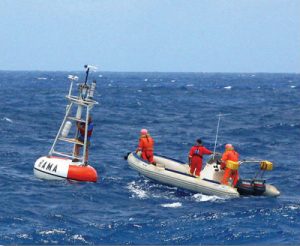NOAA Replaces RAMA Moorings in the Indian Ocean
 A team of mooring specialists from the Pacific Marine Environmental Laboratory recently replaced 5 NOAA moorings in the eastern Indian Ocean as part of the Research Moored Array for African-Asian-Australian Monsoon Analysis and Prediction (RAMA). The cruise, which took place from April 19 to May 16, 2012, began in Merak and ended in Banda Aceh, Indonesia. The Indonesian Agency for the Assessment and Application of Technology and Ministry of Marine Affairs and Fisheries provided the Research Vessel Baruna Jaya III under terms of a Memorandum of Understanding with NOAA, in which costs for implementing several sites in RAMA are shared between agencies.
A team of mooring specialists from the Pacific Marine Environmental Laboratory recently replaced 5 NOAA moorings in the eastern Indian Ocean as part of the Research Moored Array for African-Asian-Australian Monsoon Analysis and Prediction (RAMA). The cruise, which took place from April 19 to May 16, 2012, began in Merak and ended in Banda Aceh, Indonesia. The Indonesian Agency for the Assessment and Application of Technology and Ministry of Marine Affairs and Fisheries provided the Research Vessel Baruna Jaya III under terms of a Memorandum of Understanding with NOAA, in which costs for implementing several sites in RAMA are shared between agencies.
The NOAA Climate Program Office contributes to international efforts to implement a sustained global observing systems necessary for climate research and prediction as well as long-term monitoring for climate change detection and attribution. RAMA is a major component of the Indian Ocean Observing System, which is designed to improve the description, understanding, and prediction of the seasonally varying monsoons that affect one third of the world’s population. The moored array is presently 65% complete, with support coming from the United States, Japan, India, Indonesia, China, France, Australia, and the Agulhas and Somali Current Large Marine Ecosystems Project (ASCLME)— a consortium of nine eastern and southern African countries.
CPO Contact: Sid Thurston.